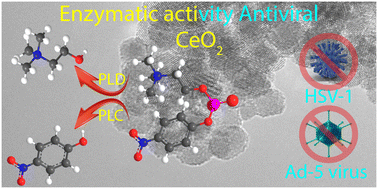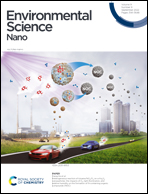How the surface chemical properties of nanoceria are related to its enzyme-like, antiviral and degradation activity†
Abstract
Five different water-based precipitation methods have been used to prepare nanoceria with significantly different redox and acid/base properties, which have been described in detail by a number of analytical methods. Differences in particle size, morphology, porosity, but especially in defect structure and in the surface chemical composition of nanoceria had a crucial impact on their reactivity in several environmentally and biologically oriented model reactions. Ceria-catalyzed hydrolysis of two phosphodiester biomolecules (p-NPPC and p-NP-TMP) revealed high phospholipase C and D mimetic activity of all tested materials. On the other hand, the efficiency in degradation of toxic organophosphates (methyl parathion/oxon, agent VX, GD) is highly dependent on the solvent used (water or acetonitrile). Water slows down the degradation rate, but has a strikingly different effect on each ceria sample, which is related to the ceria surface structure and its interaction with the model compound and/or water. Two materials with a significant number of defects and oxygen-containing surface groups also showed highly virucidal properties against enveloped (adenovirus 5) and non-enveloped (human herpes simplex) viruses while having very low cytotoxicity.



 Please wait while we load your content...
Please wait while we load your content...